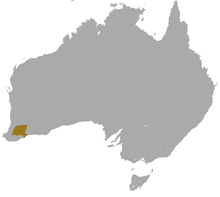Red-tailed phascogale
| Red-tailed phascogale[1] | |
|---|---|

| |
| Scientific classification | |
| Domain: | Eukaryota |
| Kingdom: | Animalia |
| Phylum: | Chordata |
| Class: | Mammalia |
| Infraclass: | Marsupialia |
| Order: | Dasyuromorphia |
| Family: | Dasyuridae |
| Genus: | Phascogale |
| Species: | P. calura
|
| Binomial name | |
| Phascogale calura Gould, 1844
| |

| |
| Red-tailed phascogale range | |
The red-tailed phascogale (Phascogale calura), also known as the red-tailed wambenger, red-tailed mousesack or kenngoor, is a small carnivorous
It is closely related to the brush-tailed phascogale (Phascogale tapoatafa), but is smaller and browner.
Taxonomy
The red-tailed phascogale or Phascogale calura is one of three members of the phascogale genus, the others being the brush-tailed phascogale (P. tapoatafa) and the Northern brush-tailed phascogale (P. pirata). The species was described in 1844 by ornithologist John Gould. Its scientific name means "beautiful-tailed pouched-weasel".[3]
Alternative names for the species include red-tailed wambenger, kenngoor (the latter in the
Description

The red-tailed phascogale is smaller and browner than its close relative the brush-tailed phascogale.[6] It is around 10 cm (3.9 in) long and weighs about 60 g (2.1 oz).[7]
As in the brush-tailed phascogale, male red-tailed phascogales die following their first mating as a result of stress-related diseases.[6] Males rarely live past 11.5 months, although females can live to three years old. In captivity males and females can survive up to five years.[8][9]
The animal can leap up to 2 m (6 ft 7 in).[7]
An
The red-tailed phascogale does not drink, as its water is metabolised through its food.[3]
Distribution and habitat
The red-tailed phascogale was once found across the whole of mainland Australia,[7] and formerly widespread throughout central and western Australia but is now restricted to the southern Western Australian wheatbelt.[12]
It is found in dense and tall
Conservation status
The animal is classified as
As of August 2022[update], the species' status under the various state and territory legislation is as follows:
- NSW: Listed as Extinct (Biodiversity Conservation Act 2016 (NSW): February 2022 list)
- NT: Listed as Extinct (Territory Parks and Wildlife Conservation Act 2000: 2012 list)
- SA: Listed as Endangered (National Parks and Wildlife Act 1972: January 2020 list)
- VIC: Listed as Extinct (Flora and Fauna Guarantee Act 1988: October 2021 list)
- WA: Listed as Conservation Dependent (Biodiversity Conservation Act 2016 (WA): September 2018 list)
Conservation measures
The species was reintroduced to the Wadderin Sanctuary in the central wheatbelt of Western Australia in 2009.[13]
Recent conservation efforts in
In a surprise to scientists, a red-tailed phascogale was observed in August 2022 at the Paruna Wildlife Sanctuary, a sanctuary run by the Australian Wildlife Conservancy 50 km (31 mi) north-east of Perth, in the Avon Valley. The species had not been seen near this location for several decades, with the closest known population around 100 km (62 mi) away to the south-east.[7]
Model species
The species is used as a
Most notably the red-tailed phascogale has been used to study the marsupial immune system, development of their immune tissues,[19] and expression of and localisation of key immune cells.[20] They have an active complement system,[21] like other marsupials,[22] and the expression levels of complement components vary in developing young.[23] The serum of red-tailed phascogales has been shown to have antimicrobial properties against some bacterial species.[24] Reference genes have been evaluated in pouch young and adults.[25]
Red-tailed phascogales also express
Given their semelparous reproductive strategy they have been investigated in terms of their immunosenescense in captivity[29] and immune response.[30]
References
- OCLC 62265494.
- . Retrieved 12 November 2021.
- ^ ISBN 978-0-7301-0484-1.
- ^ Species Profile and Threats Database. Department of Climate Change, Energy, the Environment and Water, Australian Government. 7 July 2022. Retrieved 25 August 2022.
- ^ "Red-Tailed Phascogale - Appearance, Diet, Habitat". The Animal Facts. 23 August 2022. Retrieved 25 August 2022.
- ^ ISBN 978-0-19-550870-3.
- ^ a b c d McManus S (24 August 2022). "Red-tailed phascogale spotted in WA's Paruna Sanctuary to the surprise of scientists". ABC News. Australian Broadcasting Corporation. Retrieved 25 August 2022.
- ISBN 978-1-877069-25-3.
- doi:10.1071/AM12042.
- ^ Kitchener, D.J., 1981. Breeding, diet and habitat preference of Phascogale calura (Gould, 1844)(Marsupialia: Dasyuridae) in the southern wheatbelt, Western Australia. Records of the Western Australian Museum, 9, pp.173-186.
- ^ Stannard, H.J., Caton, W. and Old, J.M., 2010. The diet of red‐tailed phascogales in a trial translocation at Alice Springs Desert Park, Northern Territory, Australia. Journal of Zoology, 280(4), pp.326-331. doi:https://dx.doi.org/10.1111/j.1469-7998.2009.00658.x
- doi:10.1071/AM11017.
- doi:10.1071/AM14005.
- ^ Beavan K (23 June 2020). "Red-tailed phascogales return to Central Australian landscape for the first time in decades". ABC News. Australian Broadcasting Corporation. Retrieved 24 June 2020.
- S2CID 229930762.
- PMID 26590457.
- ^ Stannard, H.J. and Old, J.M., 2012. Digestibility of feeding regimes of the red-tailed phascogale (Phascogale calura) and the kultarr (Antechinomys laniger) in captivity. Australian Journal of Zoology, 59(4), pp.257-263. doi:https://dx.doi.org/10.1071/ZO11069
- S2CID 6485078.
- S2CID 26070813.
- PMID 31120185.
- doi:10.1071/AM15036.
- S2CID 29065218.
- PMID 27514577.
- PMID 28504094.
- PMID 27761339.
- S2CID 51706551.
- doi:10.1071/AM16002.
- PMID 27431929.
- .
- PMID 30305168.
External links
- Phascogale calura on the Australian Government's Species Profile and Threats Database

